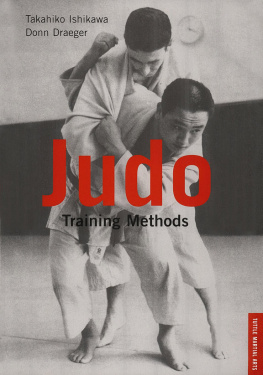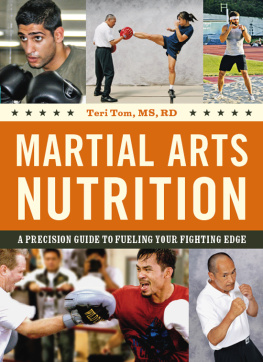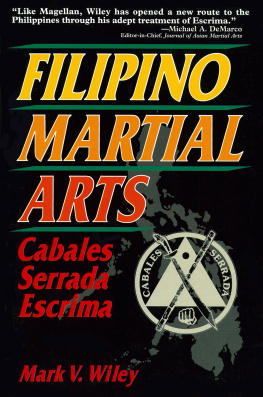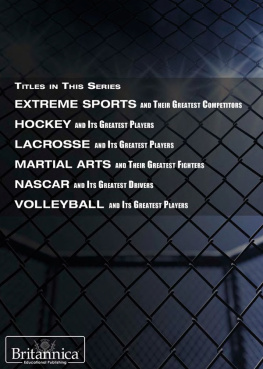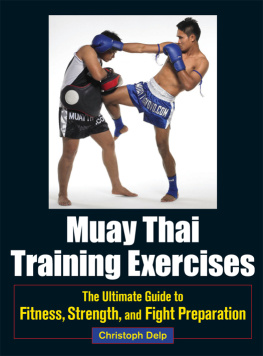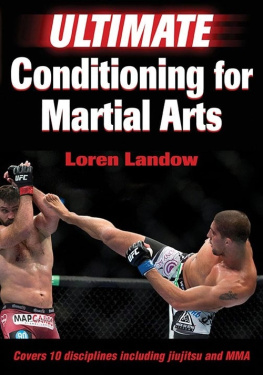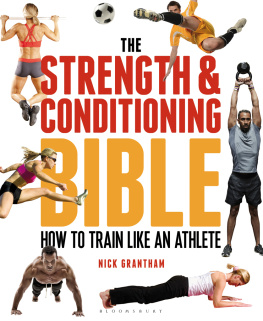CONTENTS
Guide
Will Peveler is a noted physiologist with a teaching and research focus on physiological and biomechanical factors that influence sport performance. He works as professor of exercise science at Liberty University. Peveler has a strong background in martial arts and continues to train and coach. He teaches mixed martial arts at Liberty University and is an assistant coach at The Edge Martial Arts. He is author of the Train Like a Pro book series, which also includes Training for Mountain Biking: A Practical Guide for the Busy Athlete (2021) and Training for Obstacle Course Racing: A Pracical Guide for the Busy Athlete (2021).
I would like to thank my wife, Renee, and our four sons, Grayson, Garrett, Will, and LJ, for supporting me throughout the process of writing this book, as well as the other books in the series. My wife was coerced into being in some of the photos, as well as taking some of the photos for the book. My son Grayson was also hijacked to take some of the photos as well. Without the support of my family I would not be able to do much of what I do.
I would also like to thank Justin Kilian for allowing me to yell into his office to ask questions and bounce training ideas off of him as I wrote this book. He provided an excellent sounding board for some of my programing ideas for Strength and Conditioning for Mixed Martial Arts.
I would like to thank Hayabusa Fightwear for providing photos for this book.
Last but not least, I would like to thank my editors, Christen Karniski and Erinn Slanina, for working with me during this process, putting up with all my questions, and making me sound somewhat intelligent.
T raining for mixed martial arts (MMA) requires the use of proper equipment and training facilities. This chapter provides advice on what to look for when choosing a gym for training. Every martial art has a specific name for their training facility (dojo, dojang, wushu guan, kai muay, studio, academy, etc.). To limit confusion, I use the terms facility and gym in this book. Every facility will have advantages and disadvantages; you must choose the facility that best suits your needs and goals.
This chapter also gives advice on how to choose the necessary equipment to start your MMA journey. Some of the equipment mentioned in this chapter will be necessary to start your training. Certain pieces of equipment will be nice but not required, while others will not be needed until you advance in your training. Learning what to look for when purchasing equipment will save you time and money, and possibly prevent injury. This chapter also discusses proper maintenance and care of your equipment.
TRAINING FACILITIES
One of the most important choices that you have to make is choosing the facilities in which you will train. The two main types of facilities that we will discuss are MMA gyms and strength and conditioning gyms. You may need to choose multiple gyms, depending on your goals and location. I currently train martial arts at The Edge Martial Arts, where they focus on Muay Thai, Gracie jiujitsu, and mixed martial arts. I conduct most of my strength and conditioning workouts in my home gym. You may choose to train stand-up at one facility, groundwork at another, and strength and conditioning at a third gym, or you may be lucky enough to train at a facility where you can conduct all your training in one place.
Cost is a factor that you must consider when choosing a training facility. Cost will vary greatly between facilities, and you will want to know the cost per month so that you can budget accordingly. While cost is a factor, keep in mind that you get what you pay for, and if you are serious about fighting you do not want to skimp on your training; however, there is not necessarily a strong correlation between cost and coaching level, and just because the cost is higher does not guarantee that the coaching is necessarily better. Most facilities require that you sign a contract. Make sure that you read the contract and know what you are committing to prior to signing.
Logistics is also a concern when choosing a training facility. If the drive or location is inconvenient, you may not train as often. This is one of the reasons that I have a home gym for my strength and conditioning sessions; however, I do drive 25 minutes one way for my MMA training, because the training I receive there makes it worth the drive. While not necessarily a deal breaker, it is a factor that you must consider.
Mixed Martial Arts Gym
Choosing an MMA gym can be daunting and intimidating for beginners. You will need to choose an MMA gym that best suits your needs and goals. Most gyms have free trials that will allow you to train to determine if it is a good fit. I suggest trying out a few gyms prior to committing to one. Also, most gyms allow a month-to-month contract if you need more time to decide. The month-to-month payment is typically higher per month than the contract price, but it allows you to try out the facility for a longer period of time before making a long-term commitment.
Another consideration when choosing a gym is the style of fighting. While many people argue about which style of fighting is the best, all styles have their strengths and weaknesses. MMA takes optimal techniques from all fighting styles to create an optimal fighter. MMA was built off the best of traditional martial arts. A large number of professional fighters started off in a traditional martial art and then transitioned into MMA. Many of you reading this book have probably followed the same path. But if you are interested in MMA as a combat sport, I would strongly suggest joining an MMA-specific gym, as the coaches there have already pulled the best techniques from various martial arts to create a complete program of study.
When choosing an MMA gym, you must also consider the overall philosophy, culture, and attitude of that gym. This is more important than you may believe. When you join a fight gym you are ultimately joining a family. You may not realize it in the beginning, but it is very true. Choose your family wisely. Stay away from gyms where the attitude and vibe are poor. Sit back and watch the interaction of everyone before, during, and after training. Moreover, there are gyms that have a spar hard philosophy and believe that you should spar hard every time you train. These gyms should be avoided. Hard sparring has a time and place but should be used sparingly. Choose a gym where hard sparring and egos are held in check by the participants and the coach.
One of the last things to consider is if the types of classes (Muay Thai, jiujitsu, sparring, etc.) the gym offers. Many facilities will have multiple different styles that they teach. You also must consider the availability of classes offered at that gym and if you will be able to fit them into your schedule. The gym can be an amazing gym yet not fit into your work and life schedule.
Workout Gyms
Few MMA gyms have a full workout facility for strength and conditioning; therefore, you may need to join a workout gym as well. When choosing a workout gym, there are few things you should consider. The first is that you will need to determine if they have the necessary workout equipment that you require for optimal training. There are some gyms that do not have free weights and others that may contain only free weights. Choose a gym with the mixture of free weights and machines that will allow you to accomplish your strength and conditioning goals. When choosing a gym, you also need to know what types of lifts are permitted. For example, some gyms do not allow dead lifts.
It is also important to know when the gym is open to determine if it will fit within your schedule. I advise visiting the gym during the primary time slot that you plan on training so you can determine if it is busy at that particular time. While you are visiting, make sure to ask when the high-traffic times are. High-traffic times typically extend your workout length, as there may be longer wait times on equipment.


